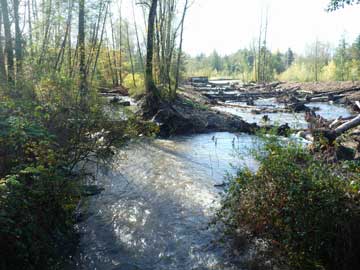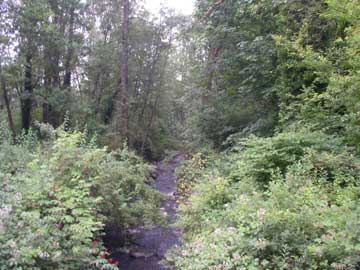Lower Boise Creek Channel Restoration Project
White River Watershed

The Lower Boise Creek Channel Restoration Project is located on a 15 acre parcel at the confluence of Boise Creek and the White River near Enumclaw.
In the 1930’s, transportation engineers relocated the lower 500 feet of Boise Creek to run between the elevated road beds of the Northern Pacific Railroad and State Route 410. This created a channelized and over-steepened stream with no floodplain or pools, and limited spawning and rearing habitat.
When King County began restoring the channel in July 2009, excavation crews discovered extensive railroad trestle debris and abnormal colors and odors in the groundwater. Soil and water tests revealed polynuclear aromatic hydrocarbons or PAH's — which are hydrocarbon compounds typical of asphalts, fuels, oils and greases — and several biologically toxic metals commonly used in wood preservatives, including arsenic, chromium and copper. King County halted construction a month later, pending re-scoping to fund and implement a comprehensive site investigation plan. King County applied for and was awarded additional funding to perform additional work from the Washington Recreation and Conservation Office, and construction resumed in June 2010. Site cleanup was completed by July 2010 and construction of the final floodplain and channel was completed in August 2010. Site planting was performed in February 2011.
The Lower Boise Creek Channel Restoration Project achieved Platinum level LEED rating based on King County's Sustainable Infrastructure Scorecard.
Project results
- Created two acres of spawning habitat for chinook, coho and pink salmon, and steelhead;
- Doubled channel length from 500 to 1,100 feet;
- Created approximately two acres of alluvial fan floodplain habitats;
- Established a 150-foot-wide buffer of native trees and shrubs along each side of the channel;
- View videos of salmon returning to spawn at the project site
- View the spring 2013 underwater video showing juvenile coho and spawning steelhead
- 2013 Monitoring Report
- 2015 Monitoring Report
In the spring of 2011, nearly a dozen pair of adult steelhead spawned in the project area. On July 5th, King County staff counted 5,000 juvenile salmonids in the project site, 25 times more than an un-restored reach upstream. King County staff, the Puyallup Indian Tribe and state biologists worked together to manage summer flows and water temperatures to benefit the juvenile salmon. Fisheries staff from the Puyallup Tribe diverted the creek into the new channel and the Washington Conservation Corps installed 850 feet of shade cloth over the creek to help keep it cool.
In September 2011 the shade cloth was removed to make way for spawning season, and tens of thousands of salmon passed through the site. As of fall 2011, the project is functioning well, stream temperatures are optimal, flows are suitable for upstream salmon migration and the project is expected to provide improved habitat for their fry when they emerge from the gravel next spring. King County staff will continue to monitor the project and work collaboratively with state and tribal biologists to ensure the continued success of the project.
2010 project accomplishments

- Moved approximately 9,000 cubic yards of soil;
- Removed 559 tons of contaminated soil;
- Removed 286 tons of creosote pilings;
- Created 600 lineal feet of off-channel habitat;
- 1.5 acre of new floodplain and old channel approximately two acres floodplain;
- Placed 150 pieces of large woody debris with 12 Key LWD pieces, all salvaged from behind Mud Mountain Dam;
- Planted 5,845 bareroot and 1,055 one-gallon potted native plants;
- Eleven steelhead redds established in new project area, or roughly 20 percent of Boise Creek steelhead spawning.
For more information about the Lower Boise Creek Channel Restoration Project, please contact Mason Bowles, senior ecologist, Water and Land Resources Division Ecological Restoration and Engineering Services Unit.

 Translate
Translate